Ray Nichels–Chrysler’s Race Connection Part 1
Creating a high-performance image, and GM’s loss is Chrysler’s gain.
By Wm. R. LaDow Photos from the Nichels Engineering Archives
Our series, “Ray Nichels—Chrysler’s Race Connection” is based on the book,Conversations with a Winner – The Ray Nichels Story, which is the culmination of a ten-year effort by its author; Wm. R. LaDow. The book relies primarily on a six-year collaboration between the author and Racing Hall of Famer Ray Nichels.
Utilizing the Nichels Engineering Archives that had been sealed for over 30 years, this book offers a glimpse in to the never before documented life of Ray Nichels and promises to be the most wide ranging narrative outlining Nichels almost 40 year racing career.
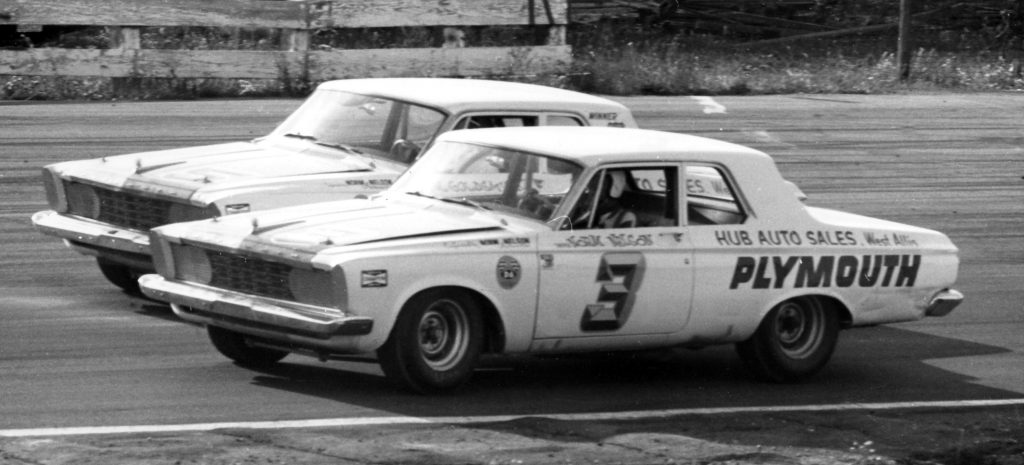
Norm Nelson and Paul Goldsmith running Nichels-built Plymouths at Illiana Motor Speedway in Schererville, Indiana during the USAC season in 1963.
The business card read …
F.R. Householder
Manager – Circuit
High Performance Competition
Chrysler Corporation
P.O. Box 1518
Detroit 31, Michigan
It should have just said … “The Man.”
F. Ronney Householder joined Chrysler Corporation in 1955 after he had completed his brilliant driving and car building career. Householder’s initial Chrysler duties revolved around fleet and high performance sales to national, state and local government agencies. At the time, Chrysler was active in stock car racing with the amazingly successful Carl Kiekhaefer team running Chrysler 300s. However their involvement ended in 1957 following the announcement of the AMA Resolution. But times were changing. With the Henry Ford II announcement on June 11, 1962 that Ford Motor Company was withdrawing from the 1957 Automobile Manufacturers Association Resolution opposing American auto manufacturing companies’ participation in stock car racing, Ronney was given new a task. Householder’s new job was to put Chrysler square in the center of American stock car racing. The President of Chrysler Corporation, Lynn Townsend let it be known that he wanted his car company to drastically change its image and become identified with the high performance market. Ronney Householder accepted his marching orders and started posthaste. The first step for Chrysler had been Gale Porter’s move to bring Cotton Owens on board with Dodge. That task having been completed in late 1962, Householder, working through his long-time connections in USAC, contacted Norm Nelson in Racine, Wisconsin. Householder and Nelson were able to agree to a deal bringing Nelson and his key engine builder Gerald Kulwicki on board running Plymouths. The Nelson deal was completed by very early 1963.
Householder had made it a point to look up his old friend Ray Nichels several times during the course of the 1962 race season at races across the country. Whenever Ronney could get Nichels alone, he always inquired if Ray was still pleased with his business arrangement with Pontiac. And why wouldn’t he? Nichels Pontiacs were dominating NASCAR, USAC, IMCA and ARCA, in addition to setting records on drag strips across America. Nichels’ shop had been expanded three times since he went into business with Bunkie Knudsen and Pontiac. The young man who used to work on Ronney’s midgets in his father Rudy’s garage had come a long way since the 1940s. Ronney knew Ray was loyal to the GM carmaker and wouldn’t expect anything less. But Frederic Donner’s memo had changed all that. Pontiac didn’t even get a say in Donner’s decision. Pete Estes and John DeLorean woke up one morning and were informed that they were to immediately cease their Pontiac business relationship with Nichels Engineering, stealing from them their most potent marketing tool, “Win on Sunday, Sell on Monday.” With GM’s announcement that it was leaving racing, Householder’s ongoing question to Nichels had been answered, albeit not by Ray.
When Ronney got the news about the GM decision to leave auto racing, he immediately contacted Ray. His question was simple. What did Ronney Householder have to do to bring Nichels Engineering on board as a Chrysler partner?
A LITTLE RE-ENGINEERING
While racers across America were getting ready for Daytona Speed Weeks, Nichels and Householder were busy holding lengthy phone discussions about the future of Chrysler and Nichels Engineering. Ray was flying back and forth to Michigan, keeping the nature of all of his discussions with Householder to himself and a few close associates. A deal was struck. But the agreement called for confidentially until certain aspects of the deal could be put in place. Both Householder and Nichels knew that Chrysler wasn’t ready just yet for racing. Nichels echoed what Cotton Owens had told Gale Porter. The cars needed more power. Chrysler racers needed the Hemi. No one knew better what the Chrysler Hemi could do than Ray Nichels. It was Nichels and Sam Hanks who set the world speed record with the Hemi in 1954 at Chrysler’s Proving Grounds in Chelsea, Michigan. It was Nichels and Pat O’Connor who did the same thing with the Hemi at Monza, Italy in 1957. There were also substantial problems with the cars themselves. Nichels’ assessment of the 1963 Chrysler body styles was they were about as aerodynamic as a “box of rocks.” Ray told Householder he knew the suspension systems weren’t much better either.
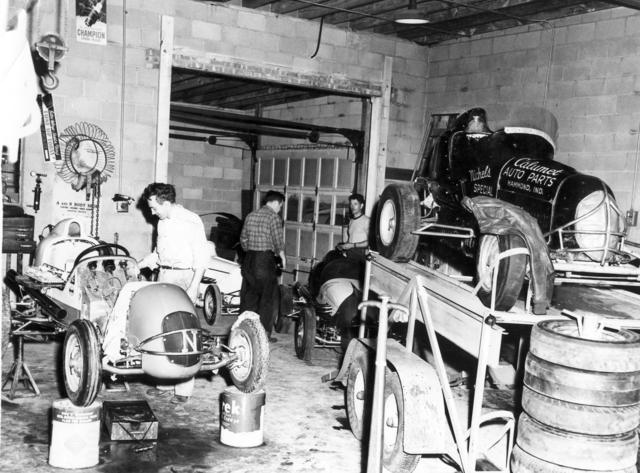
When Ronney Householder came to Ray Nichels in early 1963 and asked him to take over the Chrysler Corporation Racing Program he wasn’t talking to a stranger. Here is a photo of Rudy Nichels’ shop at the corner of Cline Avenue and Ridge Road in Highland ,Indiana in 1947. Working on the two Nichels-owned midgets in the front of the garage is 24 year-old Ray Nichels. In the back, on the right, in the white tee shirt is Householder, who at the time was one of the most respected drivers in racing. Nichels and Householder’s close friendship started in the late 1930s and lasted until Householder’s death in 1972.
Householder promised Nichels that substantial design modifications in the body and chassis would be forthcoming. He also committed to Chrysler’s intent to revive the Hemi. What Ronney needed from Ray Nichels was an agreement for Nichels Engineering to become the “house” builder for Chrysler. He needed Nichels to commit to building as many stock cars as Chrysler deemed necessary. Ronney also needed Ray to become the point man for Chrysler’s racing effort. This meant Nichels Engineering would immediately become the sole supplier of high performance parts for the American stock car racing market. In addition it meant Ray would be responsible for helping hire drivers and setting up other race teams as Chrysler deemed appropriate. But most importantly, Ronney needed Nichels to be able to grow his business, and grow it fast.
The first inkling that there was something developing occurred when Ronney Householder showed up with a box full of suspension parts in the Engineering Department of Chrysler Corporation in Highland Park, Michigan. It didn’t take long for the Chrysler engineers to figure out that the parts were from GM-Pontiac. Ronney explained exactly what he needed from the Mopar engineers. He wanted the staff to draw up blueprints utilizing the Pontiac parts within the frame work of a 1963 Plymouth Belvedere. In short order, the blueprints were prepared and readied for Ronney’s review. However, one engineer had also submitted the data from the drawings for an analysis by a Chrysler developed computer program. When the computer analysis was completed, the engineer contacted Ronney and explained that in his view, the suspension parts as constructed, would fail under stress. Householder sharply explained he wasn’t asking for any design help, just blueprints drawn up. Ronney stated simply “Get me the prints as soon as you can, I have to get them to Nichels so he can start building the cars.”
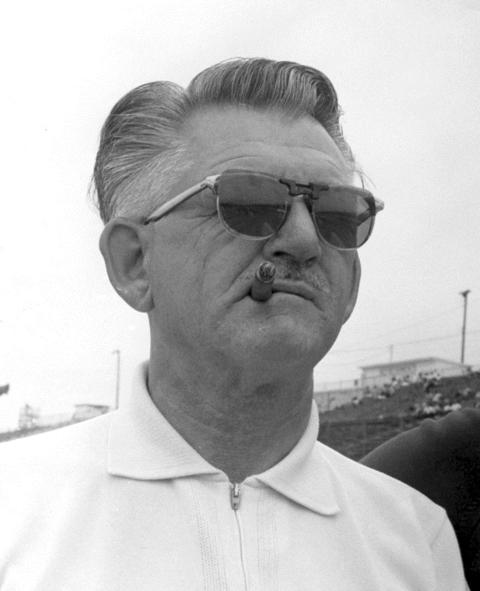
Ron Householder, Chrysler Manager of Circuit High Performance, was the catalyst behind Ray Nichels accepting Chrysler Corporation’s offer to become their “house” builder of stock cars in 1963.
BEHIND THE SCENE
It was agreed that in the short term, Nichels and Householder would keep the new business arrangement confidential. Nichels was to continue to campaign the Pontiacs he had in-house, while secretly building Chryslers in the Cline Avenue shop. Initially Nichels would have no interaction with Cotton Owens or Lee Petty, the two Chrysler teams currently running in NASCAR. Nichels was to begin supporting Norm Nelson’s USAC effort with Plymouth, as the proximity of Nelson’s shop south of Milwaukee was conducive to getting the Mopars racing as soon as possible.
Goldsmith was also a big key in the Nichels program because of his ability to explain what the cars needed during high speed testing. As a result, Paul would do very little competitive driving until mid-summer. Nichels, Worley and Goldsmith would focus their efforts on testing Chryslers and readying the Demler roadster for the Indianapolis 500. From a driver standpoint the Nichels stable would shakeout as follows … Goldsmith would test, race stock cars if needed and run Indy. A.J. Foyt would immediately begin driving one of Norm Nelson’s Plymouths, Sutton would run a Nichels Pontiac and Rodger Ward would leave the team and join Bill Stroppe’s Mercury effort. Nichels would continue to look for new driving talent and offer one-on rides during the season to prepare for a full bore Chrysler assault on the 1964 season.
The first sign within the racing community that things were changing in the Nichels organization was the March 11th announcement that A.J. Foyt was leaving his No. 02 Nichels Pontiac ride to drive the Smokey Yunick Chevrolet that Johnny Rutherford had piloted earlier at Daytona. Foyt would take over the No. 13 Yunick car for the March 17th race at Atlanta. Nichels filled Foyt’s seat with David Pearson and also took Goldsmith in the No. 01 and Len Sutton in the No. 07. These moves allowed Ray to give the illusion he was going to stay with Pontiac, yet give Foyt an opportunity to drive one of the new powerful Chevy’s being run in NASCAR. Results of the race were mixed. Goldsmith started sixth and finish 11th. Pearson and Sutton started deep in the pack and finished 26th and 38th respectively, both experiencing engine failures.
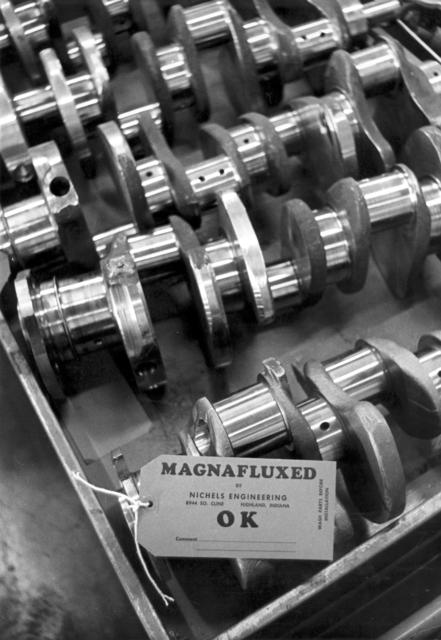
Thorough testing of all racecar components was a Nichels staple. Here cranks have been magnafluxed and approved for engine assembly.
GET CRANKIN’
Completing his commitment to run Atlanta, Ray finally had some time to start up the Chrysler program at the Cline Avenue shop. Nichels Engineering would have almost five weeks before their next race. Much had to be done, with little time available. Householder asked Nichels to initially build two new Chrysler stock cars, a Dodge Coronet and a Plymouth Belvedere. Once the cars were finished, Ronney wanted Ray to take the cars up to the Chrysler Proving Grounds. This would be an opportunity for Chrysler management and some major shareholders to learn more about Lynn Townsend’s plan to involve the company in stock car racing.
Nichels mechanics worked furiously trying to get the new Dodge and Plymouth cars completed for the trip north. Both cars were mounted on side-by-side hydraulic lifts in the main bay of the shop. After one particularly late evening, with the cars just about finished, the side-by-side lifts were left in the raised position. As the exhausted Nichels mechanics were leaving, one of them inadvertently turned off the power to the compressors that maintained the hydraulic pressure that held the lifts in place. During the course of the night, the lifts began to slowly lower themselves to the floor.
Unfortunately one of the cars also had jack stands underneath it. When the mechanics arrived at 6 AM to begin work, they found one of the nearly completed stock cars resting upside down on top of the other car. Just as the cars were being discovered by Tiny Worley, Ray Nichels happened to walk in. Ray took one look at cars sitting on top of each other, turned around, walked back to his home next door and sat down at the kitchen table without saying a word. Eleanor took one look at him and knew that whatever Ray had just witnessed in the shop, nothing good could come from her asking him about it. She made him a breakfast plate full of eggs and kept his coffee cup full. In time, Ray would quietly return to shop. But it didn’t end there.
After the body work was completed and the cars were outfitted for the trip, one of them caught fire due to an electrical short in the wiring. Nichels called and warned Householder that it was going to be a close call getting the cars to Chelsea, Michigan on time. Ray’s attempt at humor “You guys wanted a HOT car to drive on the test track” was fairly well received later once the wiring was repaired and the two Chrysler stock cars made it to the corporate meeting at the Proving Grounds on time.
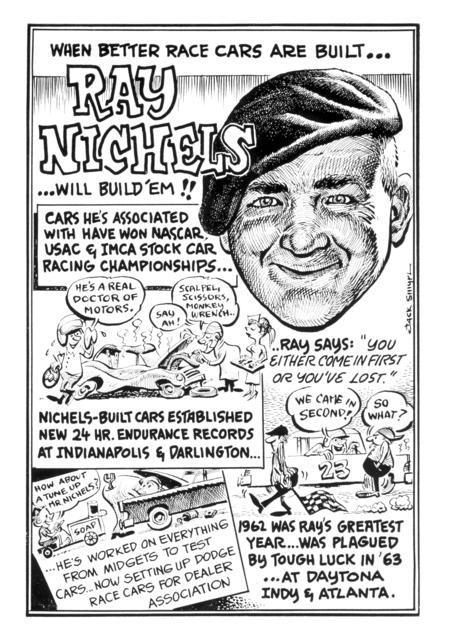
A late 1963 cartoon depicting Ray Nichels, drawn by Jack Smyrl.
UP FOR USAC
Following the successful conclusion of the “dog and pony show” at Chelsea, Nichels and his team focused on the upcoming 300 mile USAC race at the Indianapolis Raceway Park road course on April 28th. Once race day rolled around it was an eye-opening experience on many levels. Nichels had four Pontiacs in the race. They were piloted by Paul Goldsmith, Len Sutton, Lloyd Ruby, and a young SCCA sports car driver from Pennsylvania by the name of Roger Penske. The Norm Nelson Team had two 1963 Plymouth Belvederes in the race, one driven by A.J. Foyt and the other by Nelson himself.
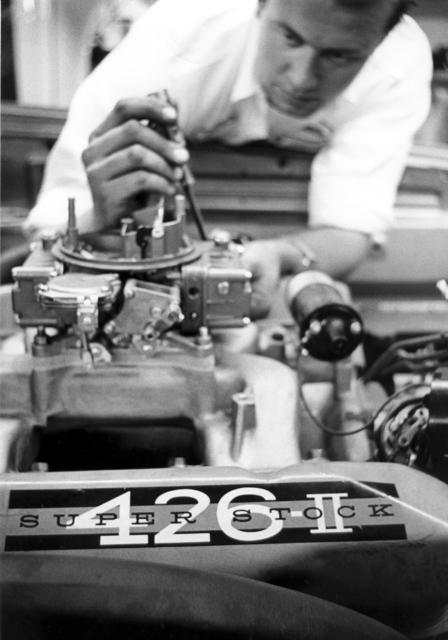
A Nichels mechanic working on one of the first Chrysler-motored cars at the Cline Avenue shop.
A crowd of 15,000 witnessed Parnelli Jones in one of the Bill Stroppe Mercurys start from the pole and led the first 28 laps. Then Penske in the No. 02 Nichels Pontiac Catalina took the lead battling alongside NASCAR star Fireball Roberts, who was running in the USAC race under an FIA license. Also in the hunt were Curtis Turner and Dan Gurney. Penske had the lead on three occasions and held it until pitting on the 97th lap. On the 108th lap, young Penske’s brilliant driving effort came to halt as his differential overheated and put the car out of the race. Foyt in the new No. 5 Nelson Plymouth held on to win the 120 lap contest. Lloyd Ruby in his Nichels No. 25 Nichels Pontiac Catalina came in second, Len Sutton in the No. 07 Pontiac came in fourth and Norm Nelson in his own No. 3 Plymouth Belvedere came in fifth. Most in attendance considered Penske’s drive the smoothest of the day and were disappointed to see a mechanical failure cost him his first stock car win. Knowing all that was going on under the radar, Ronney Householder was thrilled with the day’s success.
The USAC trail then moved on to Langhorne on May 5th with the results being just about the same. Foyt won in his Nelson Plymouth with Len Sutton coming in second in his Nichels Pontiac. Norm Nelson captured third in his Belvedere and Herb Shannon brought his Plymouth in fourth place.

Ray Nichels with chief lieutenant (and life-long friend) Dale “Tiny” Worley as they begin their work in the Cline Avenue shop on one of the first Mopar Stock Cars to be built by Nichels Engineering.
During the next week Nichels would begin to split his time between two projects—NASCAR and Indianapolis. It was the former where a young Roger Penske, driving a Nichels Pontiac, won his first stock car race.
The 47th running of the Indianapolis 500 was conducted on a day of perfect weather. But on the 149th lap, in an instant, Goldsmith and the collective Nichels Engineering effort was finished. Done in a by a failed crankshaft bearing. If the Nichels Team had to surrender this day, it was probably just as well that it happened sooner than later. Because the end of the race and Parnelli Jones’ victory was overshadowed by a controversy regarding Jones’ car reportedly dripping oil on the track and somehow avoiding being penalized for it. Clark finished second, Foyt third and defending 500 Champ Rodger Ward fourth. Goldsmith and the Nichels Team finished in 18th position. But most importantly, they all went home in one piece.
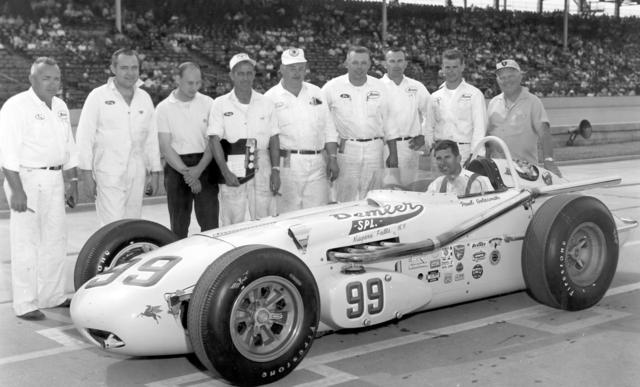
Ray Nichels and the crew of #99 Norm Demler Special. Driven by Paul Goldsmith, who laid down a 150+ MPH qualifier in the 47th running of the Indy 500, the car was the final curtain on Nichels’ Indy 500 race effort.
With the Indianapolis 500 over, it was now time to move ahead with converting Nichels Engineering into a Chrysler support entity.

